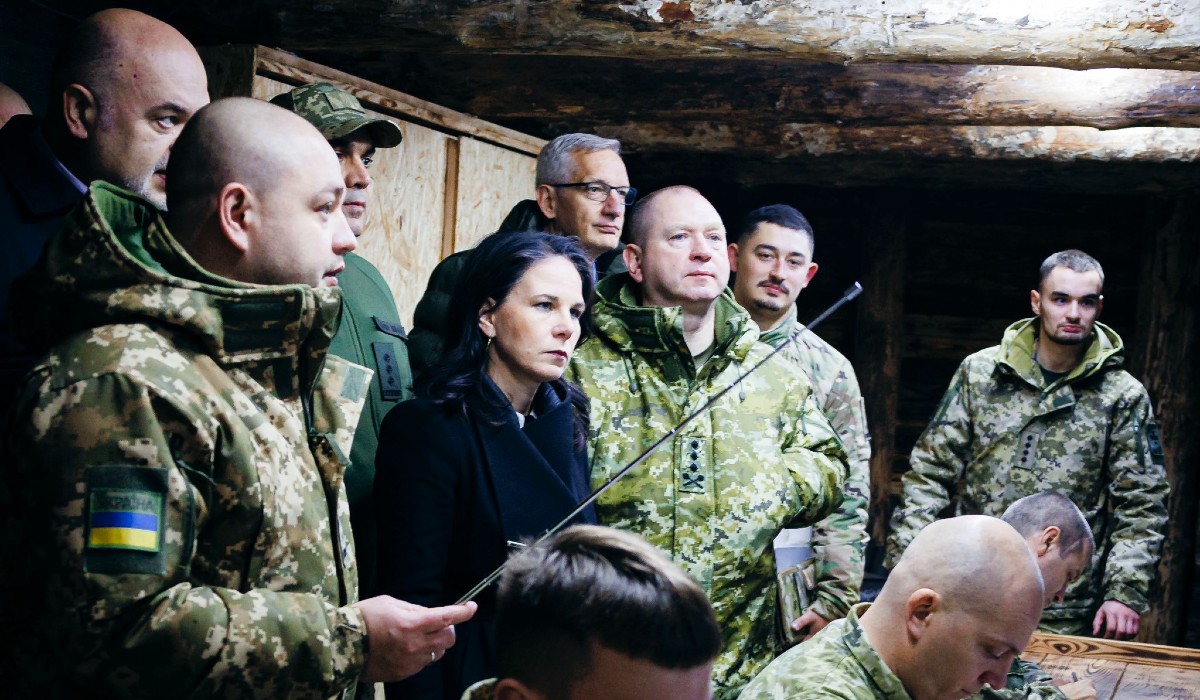A new radical left party emerged in Germany forty years ago, but its story is a warning about the importance of class for Britain’s new left party
Robert Dale lives in the Berlin region, where he has been active in socialist politics since the 1980s
Cross-posted from Counterfire

Annalena Baerbock from the German Green Party visiting a Ukrainian command post / X: ABaerbockArchiv
When the German Green Party hit the scene in 1980 it was well to the left of the Social Democratic Party. Critical of capitalism, full of Marxists, anti-nuclear and pacifist. Today it arms Israel, crushes Gaza solidarity, and is warmongering on Ukraine. It is popular in the ivory towers, despised on the shop floor. So what went wrong?
The German Green Party emerged out of the radical movements of the 1970s and early 1980s. Its key issues were the peace movement, the women’s movement, ecology and opposition to nuclear power. The idea at the time was for the party to have one foot in the movements and one in parliament, with the movements seen as more important.
Many of the members, and leading figures, had been politicised in the militant student movement of the late 1960s. That radical moment had passed but Rudi Dutschke’s concept of a ‘long march through the institutions’ seemed to offer a perspective.
The new party had electoral success with its platform of peace, ecology and diversity. In 1983, after a string of gains in state and local elections, 28 Green deputies were elected to the Bundestag. Wantonly flaunting the dress code and knitting in the chamber, this bunch of hippies and misfits scandalised the established parties and the mainstream media. Greens and left social democrats speculated about the future possibility of a radical ‘red-green’ coalition.
Trouble is, the movements were fading. By 1990, this was a party without a movement, but still capable of winning seats in local and regional government under Germany’s proportional-representation system. By the mid-1990s it was eyeing the prospect of joining a national coalition. There was one big problem, though.
Nato
The Greens now looked a good deal more respectable, but their manifesto still called for Nato to be abolished. It was clear that ditching that policy would be the price of admission to government. The relevant statements were watered down during the drafting of the 1998 manifesto and, what do you know, the Greens were able to join the SPD in Gerhard Schröder’s Blair-type government.
So what did the ‘red-green coalition’ of 1998 to 2005 achieve? Well, to start with, they took an axe to the benefits system. That was a big deal. Interestingly, no-one really held that against the Greens, while the SPD was still feeling the burn twenty years later. The pacifists in the Green Party met their Waterloo in the Kosovo War of 1999.
After reunification, the German ruling class was itching to restore its ability to wage war. That meant overcoming the deep-seated taboo on deploying German armed forces to fight abroad, which had held since 1945. Nato’s interference in Kosovo provided an opportunity to dress that up as ‘humanitarian’ and the German air force joined the bombardment of Serbia and Montenegro. Leading the charge was the Green Foreign Minister, Joseph (‘Joschka’) Fischer.
This caused a big debate in the party of course. The peaceniks lost the fight, and those with any principles left. Clearly the Greens were no longer the party of peace. Now the grotesque charade of war for human rights became their mantra.
It was to be sixteen years before the Greens got another sniff at national government. The 2000s and 2010s saw the party consolidate its base in state parliaments and local government, and drift further right. In 2016, it formed its first state-level coalition with the right-wing Christian Democrats.
A new generation of leaders emerged too. The old guard had come up through the radical movements. Foreign Minister Fischer started out as a street-fighting militant in the 1968 student movement. By contrast, the duo who led the Greens into the 2021 election, Annalena Baerbock and Robert Habeck, were squeaky-clean respectable (Habeck writes children’s books, and Baerbock spent her youth trampolining; neither appear to have been involved in politics before their parliamentary careers).
So when the Greens joined the free-market FDP in Olaf Scholz’s SPD-led coalition, they were unburdened by any expectation of radical change. Their voters did, however, expect significant action on climate issues, and protections for refugees.
What then happened was a shock, even to the cynical. When the Ukraine conflict turned to open war in 2022, Green Foreign Minister Baerbock and her party were gung-ho, leading the calls for more guns, more tanks, more war. In this they were in lockstep with the German ruling class, which treated the bloodshed as a splendid opportunity to put the German armed forces back on the map.
So the stunning remilitarisation of German society, the grotesque expansion of military spending, was initially the work of the Greens and Social Democrats. And just when you thought it couldn’t get any worse, the IDF butchery in Gaza began.
As a feminist and human-rights advocate, Green Foreign Minister Baerbock … backed Israel to the hilt. Lockstep again with the German ruling class and the Zionist state. Germany continued supplying arms to Israel and solidarity demonstrations were brutally suppressed.
Green politicians queued up to demonise empathy for the Palestinians as ‘antisemitism’. Co-leader Robert Habeck insisted that the party as a whole backed that line, and I can’t think of a single prominent Green who bucked it.
At least they did some good things for the climate and for refugees, didn’t they? Well … I hate to disappoint you, but no. Apart from tinkering with targets and slapping tariffs on imported electric vehicles that is. Their programme to enforce heating-system upgrades was poorly thought out, badly communicated, and immensely unpopular. A debacle. Their choice to replace Russian pipeline gas with expensive fracked LNG from the States achieved the triple: bad for the environment, costly for ordinary people, deadly for German industry.
And refugees? They may well find themselves banished to remote camps, after Baerbock gave her blessing to the European Union’s plans for internment at the EU’s external borders and ‘return hubs’ in third countries (fans of the EU should maybe take a closer look at its policies on asylum, war and militarisation).
So here we are. For four decades, the Greens marched through the institutions, reaching their commanding heights. In the process, they have become thoroughly institutionalised themselves. Animal Farm springs to mind.
Parliament and class
So how did this transformation come about? A good part of it is simply the well-known mechanism of bourgeois democracy. Reap the rewards of conformity or endure the pressure applied to radical critics. Who wants to be an outsider? Parliament slurps in radical currents, clips their wings, and spits them out as a shadow of their former selves.
To resist those pressures, a party needs either a vibrant movement outside parliament or some very clear ideological anchors. The Greens had neither. The movements had dissipated. By the time the anti-globalisation movement and the social forums appeared in the early 2000s, the Greens were on the other side of the barricades.
The key ideas that united the Greens, ecology and diversity, were fundamentally compatible with administration within (and for) capitalism. Opposition to militarism was not, and was dropped. Class did not feature. If they had any theory of change, they looked to a ‘coalition of the disadvantaged’.
On top of that general process of co-optation, the party’s specific class composition has influenced where it ended up. Its roots were in the student protests, its breeding grounds were the heavily middle-class peace and anti-nuclear movements. Germany, unlike Britain or France, saw comparatively little working-class action throughout that period.
You could say that the Green Party has accompanied successive generations of young university graduates in their personal ‘march through the institutions’. Some climbed higher, some less so. Today, the Green Party holds great sway in the cultural professions and beyond. Forty per cent of journalists vote Green for example.
What else do we know about Green voters? They earn more than those of other parties (apart from the free-market liberals of the FDP). And they fly more. Ironic, that one. They tend to live in the nicest parts of town.
Today, the Green Party appears to represent the class interests of the new middle class, or the ‘professional-managerial class’. Those who manage, administer and legitimise capitalism without personal ownership. Heads of organisations, HR managers, government officials, senior administrators, journalists, artists, academics and intellectuals. Not the commanding heights. Not the military or the police.
The German Green Party’s agenda is the agenda of this class. Diversity and non-discrimination within the existing hierarchy. Ecological virtue-signalling. Climate action only where compatible with the interests of capital. Foreign wars for human rights (somehow always targeting our ruling class’s enemies). A certain amount of radical talk, as long as no action follows.
We can imagine this as several layers or strata in society. At the top of this particular tree we have those in positions of real authority in their domain, who are rewarded accordingly. Heads of institutions for example. Around them are others with rather less personal power but still paid a premium to fawn (many journalists), praise (artists) or police (headteachers, senior social workers). And then there are very many university graduates on lower rungs of the same professions who may or may not be (or aspire to be) on the way up (teachers for example).
It is those lower levels who are closest to the working class, or could be regarded as part of it. Proletarianisation of the professions is a thing, but so is the prospect of advancement into the middle class proper (in the sense of those who possess some power in society but not the commanding heights). And even at the lower levels, graduates are very often in occupations that demand that they conform with and internalise the existing state of society. Journalists and social workers, for example.
A vibrant labour movement would provide an alternative pole of attraction for these strata. However, currently the working class is quiet, and these groups are tending to orientate on those ‘above them’ who exert real influence and offer material rewards.
The Palestine issue illustrates what a difference strong opposition from below can make. In the late 2010s, the political establishment and the media were able to use the antisemitism slur to wipe the floor with Jeremy Corbyn. Today, with a strong movement behind it, solidarity with Palestine has become mainstream.
These issues will be relevant for the new British left party. Will it restrict itself to the ‘woke coalition’? Diversity, ecology and a bit of social justice can be co-opted. Or will it commit to the awkward squad: anti-militarism, anti-Nato, supporting strikes, rebuilding working-class power?
It would be refreshing to see some of the Corbyn/Sultana party’s 750,000 supporters attending striking workers’ picket lines. The opportunities are there for the taking: Birmingham bins, Sheffield Lumley Street depot, Hull Trains, London Underground, just to start with.


Be the first to comment